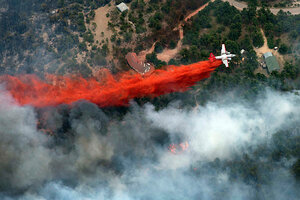Residents flee as historic Colorado wildfire burns out of control
Among several Colorado wildfires now burning, the Black Forest fire has become the most destructive in the history of the state. It remains only 5 percent contained.

An aircraft lays down a line of fire retardant between a wildfire and homes in the dry, densely wooded Black Forest area northeast of Colorado Springs, Colo., Thursday. More than 350 homes have been lost in what is now the most destructive wildfire in Colorado history, surpassing last year's Waldo Canyon fire, which burned 347 homes, killed two people and led to $353 million in insurance claims.
John Wark/AP
Loveland, Colo.
As flames continue to rage across 15,700 acres north of Colorado Springs, Colo., the Black Forest Wildfire is now the most destructive wildfire in state history, and residents in the region are struggling to cope with the scale of the tragedy.
The bodies of two local residents were found dead in their garage according to the El Paso County Sheriff Terry Maketa. The victims were found near their car, doors open as they tried to escape. More than 39,000 residents were forced to evacuate during the past few days.
Janna Szalay, a long-time resident of nearby Monument, Colo., spent the past few days torn between watching the smoke, the steady stream of evacuating residents, and comforting her daughter and friends who already lost their homes.
"It's so scary, and sad," Ms. Szalay said. "It's been so dry it's ridiculous, but the main problem is the wind and heat."
Szalay said the flames are moving so quickly through the drought-stricken area that many land owners are taking desperate measures to save their animals. "We know people who had to let their horses run free to get them out in time."
Firefighters are just coming in for the night and the news they bring with them is not expected to be positive. Early this morning, residents learned that the number of homes lost had tripled from the night before. In natural disasters like this one, it is the lack of knowledge that creates the most tension as families desperately wait for news about their homes and property. At last count, 360 homes were lost to the flames and 13,000 additional properties are threatened, and as darkness falls, the fire is only 5 percent contained.
The Black Forest wildfire is one of three major wildfires raging in the Colorado forests and nine burning in New Mexico, all near the border between the two states.
The situation in the Royal Gorge fire area in Colorado is improving, says Mike Smith, a information officer working the Royal Gorge fire. The Royal Gorge fire was 20 percent contained at last report after burning through 3,100 acres. The historic Royal Gorge Bridge is now believed to be safe, although 32 planks were reportedly damaged, though a final inspection is still needed from engineers. Most of the tourist facility buildings surrounding the bridge were lost in the fire.
Mr. Smith says confidence is high with the fire crews who are comfortable with how this fire is behaving.
"There is some extreme fire potential," Smith says, "but we've had high relative humidity and low winds, so the crews made good progress."
Two local highways were closed for several days for the protection of residents who Smith reports were very cooperative.
"Most of the fire activity is on the south and west sections of the fire, away from the highways, so we are focusing on reopening the highways as soon as possible," he adds.
Across the border, New Mexico firefighters continue to struggle with fires in difficult terrain. The greatest concern is for the fires threatening homes, says Larry Helmerick, public information officer for Northern Arizona's Type 2 Incident Management Team.
Because of the Silver City fire in the Gila National Forest, 250 residents in Kingston, N.M. were evacuated Thursday. At last report, the lightning-sparked Silver City fire burned through 18,800 acres of extreme, rugged terrain with zero containment.
"Our No. 1 priority in the forest land is protecting historic cabins and structures, including a watchtower near Hillsboro, N.M., which we have wrapped in aluminum for additional protection," Mr. Helmerick says.
"This is a hundred year fire for this area," he adds, "with high temperatures, dry storms, and extreme drought. We have a lightning storm overhead right now that is causing us all great concern."
The cycle of drought and wildfires is typical for the American Southwest, but most wildfire experts believe the amount of damage caused by these fires could be mitigated. According to Dan Ware, fire prevention and outreach program manager for the New Mexico State Forestry Department, burnout operations that clear dead trees and vegetation help tremendously in reducing the damage from wildfires.
"Many of these areas were unpopulated 100 years ago," Mr. Ware explains. "When a fire started, it burned through the dry vegetation and the forest was able to renew itself."
The situation changed as communities continued to grow. When people started building in these areas, they also extinguished fires as quickly as they started so the forest wasn't able to clean out dead vegetation and renew itself.
These fires are the result of a mix of dry vegetation or fuel, high winds, and intense heat. "Most of the state of New Mexico is in an exceptional drought condition and close to setting a drought record," Ware says. "The worst drought on record was in the 1950s with six years of extreme drought. However, we've now had two of the driest years on record and we are on pace to match and surpass the previous record."

